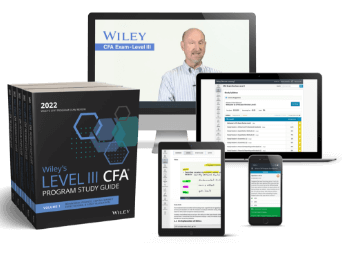CFA Level III Questions
The last step on your CFA journey is the Level III exam. The format shifts again, but practice questions remain a vital part of every successful study plan.
CFA Level III questions will test how well you’ve mastered the concepts and ask you to use that knowledge and apply it to real-life situations when you take the actual CFA exam.

CFA Level III Questions Quick Facts
- According to the CFA Institute, Level III pass rates are at around 39%.
- The CFA Level III exam format consists of a combination of item set questions and constructed response or essay questions.
- The most heavily weighted topic areas on the Level III exam are Portfolio Management and Wealth Planning.
- The exam is split into a morning session and an afternoon session.
- With a wide variety of practice questions and mock exams, Wiley covers all of your CFA exam prep needs to help you pass on your first attempt.
Can You Pass These Level III CFA Practice Exam Question Examples?
You’ll find some multiple-choice questions during this session as well, some of which are followed by an essay question where you will be asked to justify your response.
The second session of the CFA Level III exam consists of 44 multiple-choice item sets which are followed by a vignette with 4 or 6 multiple-choice-type questions. You’ll be asked to answer based on the information in the vignette as opposed to the free-standing answer items you found on the Level I exam.
Use our Level III Test Bank to identify your strengths and weaknesses and check that you can apply what you have learned with 110 multiple choice questions and approximately 75 constructed response questions that are close to those you will see on exam day.
CFA Level III Ethics Questions
The Level III Ethics questions are more complex than Level I or Level II, testing your ability to evaluate and explain how a stance does or does not violate the Code and Standards. There’s also an added weight on GIPS (Global Investment Performance Standards) and a new section on Asset Manager Code of Professional Conduct.
Learn more about CFA Level III topic weights.
Level 3 Constructed Response Example
Three friends who work on the proprietary trading desks of separate banks in New Zealand have been discussing NZD movement. The traders’ statements appear in Exhibit 1.
Level 3 Exhibit 1-1 Example
Trader |
Comment |
|---|---|
| Amy-Lee | “With the RBNZ meeting tomorrow, I’m expecting currency fluctuations to jump over the next few days. This represents a good opportunity, regardless of the direction of the exchange rate.” |
| Bree | “The currency has plenty of support at 71 cents and is not likely to have any short-term resistance until it gets back toward 75 cents. I’m going to trade forward contracts over the next few weeks to take advantage of this.” |
| Colin | “I’m really only interested in a play on the interest rate differential between the two countries. I think the currency stays flat for the next few months, and any appreciation will be a bonus.” |
- For each Trader in the first column, determine which strategy is likely to be utilized for the Currency Trading Strategy by selecting from the list provided. A selection may be used once, more than once, or not at all.
- For each Trader in the first column, determine the most likely position that the trader will utilize for the Currency Position column by selecting from the list provided. A selection may be used once, more than once, or not at all.
Currency Trading Strategy
Amy-Lee
- Carry trade
- Fundamental trading
- Technical trading
- Volatility trading
Bree
- Carry trade
- Fundamental trading
- Technical trading
- Volatility trading
Colin
- Carry trade
- Fundamental trading
- Technical trading
- Volatility trading
Currency Position
Amy-Lee
- Short NZD/Long USD forwards
- Long NZD/Short USD forwards
- Short NZDUSD call options
- Long NZDUSD call and put options
Bree
- Short NZD/Long USD forwards
- Long NZD/Short USD forwards
- Short NZDUSD call options
- Long NZDUSD call and put options
Colin
- Short NZD/Long USD forwards
- Long NZD/Short USD forwards
- Short NZDUSD call options
- Long NZDUSD call and put options
Level III CFA Exam Question Answers and Explanation
Trader |
Currency Trading Strategy |
Currency Position |
|---|---|---|
| Amy-Lee | Volatility trading | Long NZDUSD call and put options |
| Bree | Technical trading | Long NZD/Short USD forwards |
| Colin | Carry trading | Long NZD/Short USD forwards |
Amy-Lee
- Amy-Lee is looking to profit from an increase in volatility of the exchange rate. This is volatility trading.
- Amy-Lee could profit from increased volatility by purchasing a combination of NZDUSD options (puts and calls), the prices of which will increase as volatility increases.
Bree
- Bree believes that the exchange rate can be forecasted using historical price movements. Bree is trading the currency using technical analysis.
- Bree believes that the exchange rate will continue to go up and will enter a contract to capture NZD appreciation. The value of the short USD position will increase as USD depreciates.
Colin
- Colin hopes to profit from the interest rate differential between New Zealand and the United States and would be taking advantage of the carry trade.
- To take advantage of the forward discount on the NZD, Colin will go long NZD/shortUSD forwards. His breakeven will be if the spot price falls by the forward rate discount, but he will profit if the exchange rate stays above this level (i.e., only a small depreciation or any appreciation).
A. Answer and Explanation
Amy-Lee
- Amy-Lee is looking to profit from an increase in volatility of the exchange rate. This is volatility trading.
- Amy-Lee could profit from increased volatility by purchasing a combination of NZDUSD options (puts and calls), the prices of which will increase volatility increases.
Bree
- Bree believes that the exchange rate can be forecasted using historical price movements. Bree is trading the currency using technical analysis.
- Bree believes that the exchange rate will continue to go up and will enter a contract to capture NZD appreciation. The value of the short USD position will increase as USD depreciates.
Colin
- Colin hopes to profit from the interest rate differential between New Zealand and the United States and would be taking advantage of the carry trade.
- To take advantage of the forward discount on the NZD, Colin will go long NZD/shortUSD forwards. His breakeven will be if the spot price falls by the forward rate discount, but he will profit if the exchange rate stays above this level (i.e., only a small depreciation or any appreciation).
CFA Level III Questions – Frequently Asked Questions (FAQs)
Here are some answers to the most frequently asked questions about Level III CFA practice questions.
- There are plenty of places to get practice questions, and even free CFA Level III questions, but you won’t find a more comprehensive group of practice questions, practice tests, and study materials than you’ll find with Wiley CFA.
- With over 340 recommended study hours, many CFA charterholders consider the CFA Level III exam to be the toughest in the CFA Program.
- Topics and questions can sometimes repeat themselves throughout the CFA exam, though many will be presented in a different way to keep you alert.
- You beat the Level III CFA exam with an effective study plan you stick with and the best CFA study materials from Wiley.
- Yes, the CFA Level III exam is computer-based instead of paper-based.
- No, the CFA exam is not all multiple choice as Level III introduces an essay format called constructed response.
We use cookies to learn how you use our website and to ensure that you have the best possible experience.
By continuing to use our website, you are accepting the use of cookies.
Learn More




